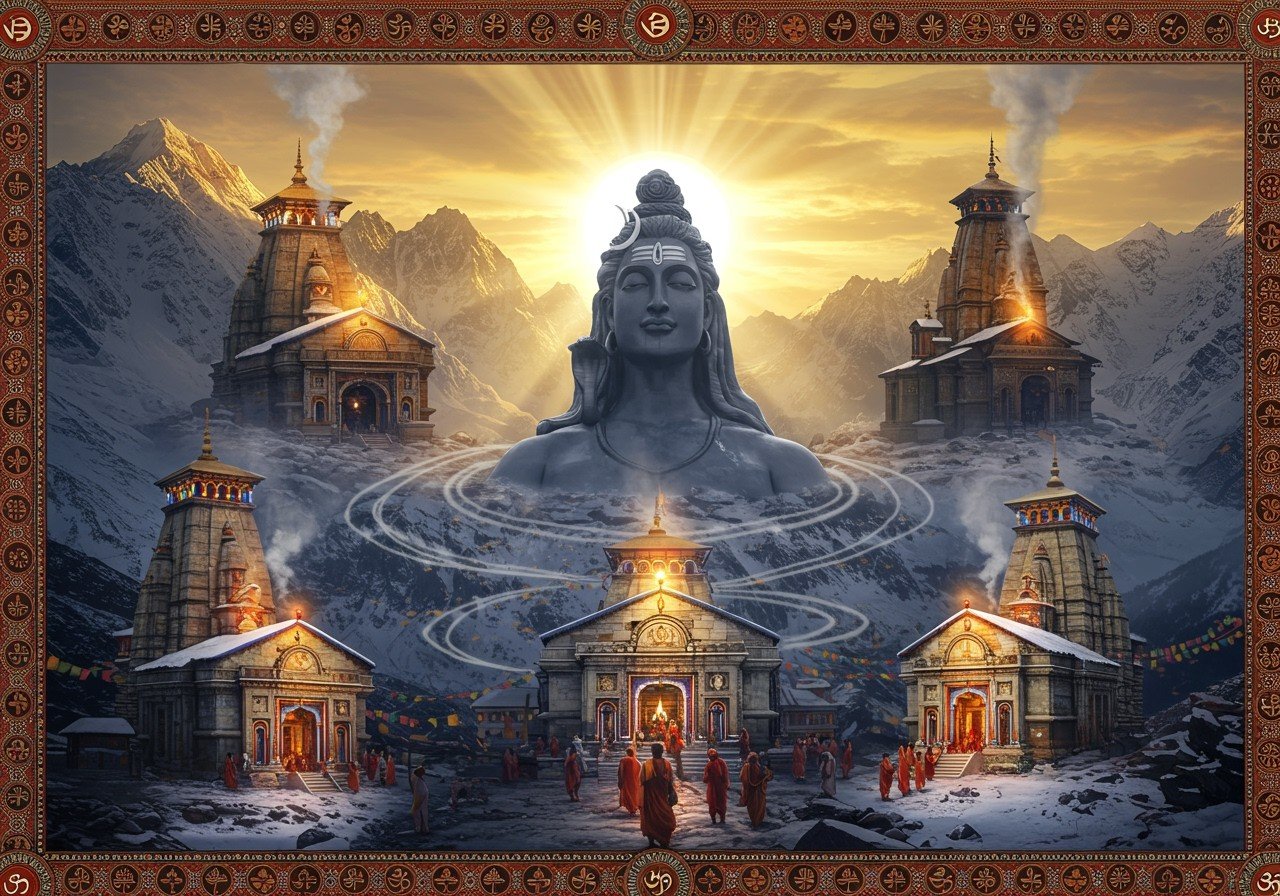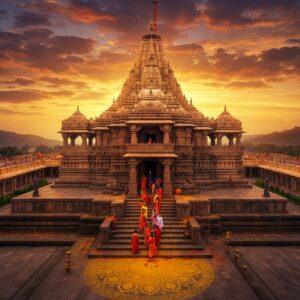
Embarking on the Panch Kedar Yatra is not just a pilgrimage; it’s a deeply spiritual experience for devout Hindus. This sacred journey takes you through five revered shrines dedicated to Lord Shiva, nestled amidst the breathtaking Garhwal Himalayas of Uttarakhand. The Panch Kedar Yatra in 2025 offers a unique opportunity to connect with your faith, explore ancient temples, and witness the stunning natural beauty of the Himalayas.
The Legend of Panch Kedar
The Panch Kedar temples are steeped in rich mythology, connected to the Pandavas of the Mahabharata. Legend has it that after the Kurukshetra war, the Pandavas sought Lord Shiva’s blessings to atone for their actions. Lord Shiva, wanting to test their devotion, eluded them by taking the form of a bull. He finally relented, revealing himself in five different locations, each representing a part of his divine form. These locations became the sites of the Panch Kedar temples.
- Kedarnath: Where Lord Shiva’s hump emerged. This temple is known for its majestic architecture and spiritual energy, a place where devotees feel an immediate connection with the divine. Poojn.in offers a beautiful collection of Lord Shiva idols for your home shrine.
- Tungnath: Marking the spot where Lord Shiva’s arms appeared. Tungnath holds the distinction of being the highest Shiva temple in the world, offering breathtaking panoramic views. Adorn yourself with sacred jewellery from Poojn.in to enhance your spiritual experience.
- Rudranath: Where Lord Shiva’s face was revealed. This temple is unique for its natural rock formation resembling the face of the deity, a true marvel of nature and devotion. Prepare for your journey with natural and auspicious cosmetics from Poojn.in.
- Madhyamaheshwar: Representing Lord Shiva’s navel. Surrounded by lush meadows, this temple offers a serene and tranquil atmosphere, perfect for contemplation and prayer. Carry Prasad and holy food items from Poojn.in for your offerings.
- Kalpeshwar: Where Lord Shiva’s hair (jata) appeared. This temple, uniquely situated within a cave, is open throughout the year, beckoning devotees to seek blessings regardless of the season. Find all the essential puja utensils you need for your pilgrimage at Poojn.in.
Planning Your Panch Kedar Yatra in 2025
Best Time to Visit: The ideal time for the Yatra is during the pre-monsoon (April to June) and post-monsoon (September to November) seasons. May offers pleasant weather with temperatures between 10°C to 20°C. Avoid the monsoon season (July-August) due to heavy rainfall and potential landslides. Winter (November to April) brings heavy snowfall, which can close temple routes.
Duration: A Panch Kedar Yatra typically takes around 11-12 days, including travel time and acclimatization. The journey covers approximately 110 km, including road travel and trekking.
Opening and Closing Dates 2025 (Tentative): Always confirm the latest dates with official sources closer to your travel time.
- Kedarnath: May 2, 2025 to October 23, 2025. Remember to book accommodations in advance, especially if traveling during peak season.
- Madhyamaheshwar: May 18, 2025 to November 17, 2025. This temple, nestled amidst serene landscapes, is a must-visit for those seeking tranquility.
- Tungnath: May 2, 2025 to November 1, 2025. Prepare for a higher altitude trek to reach this temple and be rewarded with stunning views.
- Rudranath: May 18, 2025 to October 17, 2025. Experience the unique rock formation and feel the divine presence of Lord Shiva.
- Kalpeshwar: Open year-round. This temple is accessible throughout the year, offering a spiritual retreat even during the winter months.
Preparation: The trek requires a good level of physical and mental fitness. Train your muscles, improve cardio and strength, and build a strong core. Gradual ascent, rest, and hydration are crucial to prevent altitude sickness. Hiring a local guide is highly recommended for navigating the terrain and learning about the cultural significance of the region. Respect the environment by practicing responsible trekking and supporting sustainable tourism. Explore our range of traditional herbs and wellness products at Poojn.in to support your health and well-being during your journey.
Poojn.in: Your Companion on the Spiritual Path
Poojn.in is here to support your Panch Kedar pilgrimage by providing all the essential puja items you need for a fulfilling spiritual experience.
- Complete Puja Kits: We offer specially curated puja kits for each of the Panch Kedar temples. These kits contain all the necessary items for performing rituals, ensuring a smooth and convenient worship experience.
- Sacred Items: Find a wide selection of high-quality puja items, including copper kalash, puja thalis, cotton vastras, rudraksha malas, ghee wicks, dhoop, camphor, and Gangajal, all carefully packaged for safe travel.
Visit https://www.poojn.in/product-category/pooja-samagri to order your puja samagri or contact us at 03369029784 or WhatsApp us at 9476142738. We offer pan-India delivery with secure packaging. For bulk orders or customized puja kits, please contact our customer service team.
Note: Please check with local authorities for specific temple rules about carrying puja items.
Embrace the Journey
The Panch Kedar Yatra is more than just a physical trek; it’s a transformative journey that deepens your connection with your spiritual self and India’s rich cultural heritage. May this pilgrimage be a source of peace, enlightenment, and profound self-discovery.
Frequently Asked Questions About the Panch Kedar Yatra
What is Panch Kedar? Panch Kedar refers to the five revered temples of Lord Shiva in Uttarakhand, each linked to a part of his divine form. These temples – Kedarnath, Tungnath, Rudranath, Madhyamaheshwar, and Kalpeshwar – are nestled within the majestic Himalayas.
Why is it significant? The Panch Kedar Yatra holds immense spiritual importance for Hindus. The pilgrimage is believed to bestow blessings and cleanse the soul. It’s also an opportunity to experience the natural beauty of the Himalayas.
When is the best time to visit? The ideal time to undertake this journey is between April and June (pre-monsoon) or September and November (post-monsoon), avoiding the heavy rains and snow.
How can I prepare? Physical fitness is key. Focus on strengthening exercises, cardio, and building stamina. Gradual acclimatization to the altitude is crucial. Pack appropriate trekking gear, including sturdy shoes, warm clothes, and rain protection.
What can I expect during the trek? Expect challenging yet rewarding treks, breathtaking landscapes, and a chance to connect with nature and your inner self.
Are there accommodations? Yes, basic accommodation is available near the temples. Booking in advance is recommended, particularly during peak season.
Bijli Mahadev: The Lightning Strikes Explained
Bijli Mahadev Yatra Guide: Planning Your Pilgrimage
Manimahesh Kailash Yatra: A Complete Guide to the Sacred Journey
Manimahesh Lake: Exploring Its Sacred Importance


